
I dabble in genealogy. Diane and I have both had the Ancestry DNA tests, and those reflected our reasonably fleshed-out family trees to be of a standard European-American mix that includes quite a bit of Scottish heritage. Although going back to Italy is on the bucket list, we decided that Scotland needed to be discovered more than returning to a country that we had already visited. Diane had been stationed in England back in the 1980s but had not seen Scotland, while I had done another quick weekend in London around that same time as the extent of my UK experience. According to Diane, I apparently managed to be there for the only weekend of sunshine for that year. Regardless of all that, the pictures and stories of Scotland, from Rob Roy and William Wallace to the Queen of Scots to Culloden Moor, the appeal of Scotland stands unique, the Outlander TV series notwithstanding.
I’ll admit to a relative lack of knowledge about the geography of Scotland, so I bought my now standard Rick Steves’ book on Scotland, and once again began watching videos and reading as much material as I could find.
It is always tempting to push the schedule: to be more aggressive and fit more in a two week stay. Being in the United Kingdom invites going to England, but despite much study of the possibility I decided to keep the trip entirely Scottish.
Summer is the most popular time for tourists in Scotland. However, I understand that the crowds get ridiculous during July and August. Apparently a small swarming pest known as a midge also becomes a problem in late summer. I’d love to see the Military Tattoo in Edinburgh, but it is an August event. All things considered, the shoulder season of May or September looks to be the best time to go. We’ll choose May, since the locals are still “fresh”. Living in a tourist area myself, I can relate to being burned-out with the company of tourists by the end of the season. The rainfall and temperature averages look reasonable for late May as well.
The consistent theme with my European travels is that, for my geographic location at least, Delta remains the best and least expensive option. I do check prices on other options, but Delta continues to be the choice. I looked at flying into London, Glasgow and Edinburgh, ultimately picked the Atlanta to JFK, JFK to Edinburgh route for economies of time and cost.
Keeping with the now standard Big City Experience to start the trip, we decided to stay in Edinburgh for arrival and jetlag recuperation plus two full days. I’m hoping to get some time on the second day to see the famous Rosslyn Chapel. We’ll take the train from Edinburgh Airport (EDI) to our hotel near the Royal Mile.
After Edinburgh, it will be time to get a car. We’ll take the train from Edinburgh back to EDI, get a previously booked car, and head for two nights at Stirling. From Stirling, there is driving to Falkirk to see the Kelpies, Doune Castle from Outlander, and the William Wallace monument.
To break up the drive to Skye, we’ll go along Loch Lommond and spend one night in Glenfinnan. Hopefully we’ll have time to view the famous Glenfinnan Viaduct.
We’ll catch the ferry at Mallaig to Skye, spending two nights in Portree. Hopefully one full day is sufficient to see the Skye sights by car.
Driving from Skye to Inverness, hopefully there will be time for stops at Eilean Donan Castle, Urquhart Castle at Loch Ness, and then on for one night at Inverness.
I’m not really planning on seeing Inverness except for perhaps the Castle and Cathedral as time permits, though I may regret that. Instead the plan is to drive on to see Culloden, Clava Cairns, and Cawdor as we make our way to Pitlochry.
There are Highland Games at nearby Atholl during our stay, so hopefully we’ll take that in, as well as sights such as Balmoral, Dunkeld and Braemar Castle.
On the last day, driving back towards our hotel at EDI airport, we should have time to see Saint Andrews.
With apologies for being somewhat redundant, the final itinerary is:
Big Question: Is this schedule too aggressive?
Answer: I’ll admit that this schedule is very different compared to our other travel adventures, but I am convinced that this will provide the broadest Scotland experience for the two weeks we have available. Much of Scotland’s beauty appears to be in the broad areas of the Trossachs, Glencoe and the Cairngorms. It seems to me that the easiest way to see these sights is to be able to do it at our pace, stopping to take in the view whenever we feel like it. That is the reason for so much car travel. Time will tell if I made the right decision.
Another Big Question: Is there a language thing?
Answer: Aye, I am a wee bit concerned that I don’t ken all the bonny language, especially the auld Gaelic. To be honest, I did look at some Scottish Gaelic language learning videos on YouTube. What a language! Gaelic is much too daunting to learn given the lack of real need and the relatively short amount of time before traveling. I am convinced that we will be able to make ourselves understood, even though it may involve some sign language.
: There are several nagging concerns whenever a large (read expensive) trip such as this is about to take place, but it boils down to the notions of “Will everything maintain status quo between now and when the trip occurs?” and “Will my travel arrangements work out to get me from my home to my destination and back again as I expect?” On this particular journey, it turned out that we were to be challenged on both of those notions.
The first challenge was entirely unexpected. For background, Diane and I usually do a daily walk in the evening of approximately two miles. We live near a golf course and prefer to walk the nine holes worth of cart paths to avoid street traffic. We walk through our backyard to get to the golf course. Three days before the flight, walking through that backyard, our lawn sprinklers unexpectedly activated. Diane screamed as a soaker popped up directly between us (I may or may not have screamed as well, I conveniently don’t remember). We both turned to run, but Diane grimaced and suddenly dropped straight to the ground. Thinking she had merely slipped, I reached down to help her up. She shook her head, wincing in pain. I stepped on the offending sprinkler to stop the flow of spray, slowly realizing that our trip had just been impacted.
Diane had pulled the muscle in her right thigh.
One thing to know about touring a large city is that it normally involves a lot of walking. We knew this from experience, and immediately we did everything we could to minimize the pulled muscle damage. Ice packs, bed rest and an elevated leg were the rules for the next three days. The morning of the flight, Diane was able to walk, but only at a slow and deliberate pace. There was no doubt that we could do the trip, but the pace was going to not be at our usual speed. She really needed at least one more day, which conveniently segues to the next topic…
: Our previous flights to Europe had followed the same formula as residents of the Deep South: fly from the local airport to Atlanta, then from Atlanta to Europe. The trip to Austria had involved catching a follow-on flight at Paris, but the weather had cooperated and there was no problem. The skies over Atlanta can often be unpredictable, and we ran into this on this trip. We were delayed leaving our regional airport due to storms, but air traffic was likewise being delayed in Atlanta. Despite having a three hour scheduled layover in Atlanta, we were unable to takeoff for nearly that long. We arrived at JFK International Airport about 20 minutes before our flight to Edinburgh was scheduled to leave. Unfortunately JFK is both big and busy, so it took us that 20 minutes to taxi to our arrival gate. We hurried as best we could to our departure gate, hoping the flight had been held. Unfortunately for us it had left on time.
A brief inquiry showed that the next flight was in 23 hours – in other words, same flight, next day.
Talking with Delta representatives resulted in our being booked on that next flight and being handed three airplane blankets a piece. I leveraged my Hilton Diamond status to try to find a local hotel – none were available. Apparently the weather had been awful at JFK for three days, resulting in a tremendous backlog of passengers from cancelled flights. The closest hotel was a Hilton Garden Inn that was two hours away and normally wanted $350 a night, but because of my Diamond status they were willing to give it to me for the amazingly low price of $320 – no thanks. Some of the 15 or so of us who were trying to get to Edinburgh opted for something along that line. Others took the option to fly into London in the morning instead and take the 5 hour train ride from London to Edinburgh. We considered all options, but ultimately we simply took our blankets and headed to Terminal 4, where at least there were some eating establishments available.
I especially sympathized with an elderly German couple who had missed their plane to Berlin and couldn’t seem to comprehend that they were stranded at JFK for the night. The old gentleman asked for help, as a non-native English speaker, to interpret what he was being told by the by the young, urban Delta employees at the gate. The dismay in his eyes was heartbreaking as he realized he and his wife were sleeping in the terminal that night.
The upside to this misfortune was that Diane was able to stay off of her injured leg an extra 24 hours. The natural downside was that we were trying to sleep in chairs in a noisy terminal for a few hours. It was never comfortable for the six or so hours that we tried to sleep, and machines of the cleaning and maintenance crews stayed bustling throughout the night. We were still in relatively good spirits though, pleased both by the tasty food we were getting from Shake Shack and by the fact that Diane’s leg was continuing to show improvement.
I remain disappointed in Delta for not opening their relatively comfortable and otherwise empty and locked Sky Club to those of us stranded by our missed flights.
It was with relief that we finally boarded our aircraft at JFK, exchanging tired but friendly greetings with our fellow refugees from the missed flight the night before. The flight from JFK to EDI itself was what we had come to expect, with the usual generous amounts of food and wine despite the relatively short flight time of six hours. Seats on this Airbus were three across, and we had the pleasure of having an Edinburgh native sitting with us. We discussed many things, such as the correct pronunciation of Edinburgh as “Edinburra”, and the failure of Edinburgh to produce a reasonable subway/tram system.
: I’ve gotten used to the idea that when you first enter a different customs zone, there will be a delay. I was prepared for the line, though compared to larger airports the queue for customs at EDI seemed slightly small and amateurish. We still managed to be processed in a reasonable time.
: Baggage was delivered in a timely manner. I made the mistake of picking the wrong ATM (Travelex) to do an initial draw of British Pounds, incurring a surcharge that ruined my exchange rate. Note to self: from now on always use a Royal Bank of Scotland (RBS) ATM. After getting some cash, we took a moment to relax at a small, utilitarian coffee shop near the baggage claim. Our usual mindset is to power through that first day, so we simply grabbed a booth and reenergized with a fresh coffee.
: Edinburgh’s airport aligns well for all options for leaving the airport. A line of buses is controlled by a single line with easy ticket purchase options at the booth. The much maligned tram is a short distance from the buses. I could see the rental car center was easy walking distance from there. Equipped with knowledge gleaned from our fellow traveler on the airplane, we chose the cheaper and theoretically better bus to get us to the end of the line at the Princes Street Station.
The bus was clean and the driver was professional. We both enjoyed the ride and the views provided by the double-decker bus. The climb from the station to our hotel was a bit daunting as we proceeded up the steep incline with our luggage in tow and Diane still recovering, but the buildings were beautiful and the walk enjoyable.
: Our Hilton Edinburgh Carlton hotel was excellently situated a few feet from the Royal Mile. Bagpipes sounds were a plenty from the many street performers in full highland regalia. In keeping with our standard of powering through the first day after flying, we set off at a slightly slower pace than usual. Pubs and amazing architecture was the norm as we made our way north towards the castle. Much like other cities we have visited, much of the Royal Mile has limited traffic and is very pedestrian friendly. The importance of having a hotel that is either in the old town or very near cannot be overemphasized. We were within relatively easy walking distance of all major sights in Edinburgh. Plenty of street side pubs with small outdoor seating areas sported signs hawking traditional Scottish favorites such as haggis and Scotch eggs. The temperatures were not the cold we expected, and the Scottish weather was uncommonly sunny. It was fun to see so many people out in the public parks near the castle, laying out and enjoying the sunshine. I think more than a few had some nice sunburns by the end of the day. Even my Florida skin had some extra pink in it after our visit.
Based on the successes of purchasing “city pass” cards in Florence, Paris and Vienna, I had endeavored to find the same for Edinburgh. The closest I could find was the Historic Scotland Pass. The only Edinburgh location we were able to use it for was Edinburgh Castle, but it was later to cover expenses for Stirling, Doune and Urquhart Castles as well. The validation booth was easy to find near the entrance to Edinburgh Castle. I believe it was worth the price, though I didn’t get to use the pass as much as I had hoped.
: Despite Diane’s injury, we used our feet to traverse Edinburgh almost exclusively. Some of what we had wanted to see and do was limited by the 24 hour loss we had suffered when we missed our flight at JFK. At least the delay meant that she was able to walk and maintain almost the same endurance as we normally would, so we were feeling lucky to be able to see and do what we could.
Edinburgh has a wonderful bus system, but my only experiences with it were travelling to and from the airport.
After our too short time in Edinburgh, it was time to move out of the city and into the country. The start of this process was picking up our rental car at the airport. The process was painless, and we were pleased with the nice little Vauxhall SUV automatic that we were given.
: I don’t know that anything quite prepares you for that first time of driving on the left (wrong) side of the road. Decades of driving on the right side orients all of your instincts to that perspective. Any sudden or unexpected event while behind the wheel kicks those old instincts into gear, resulting in snap decisions based on the situation. I tried to keep that knowledge in the forefront of my mind as we pulled out of the parking lot. I found myself compensating too much to the left, touching the curb on one or two occasions. Something about moving to that left seat… I had to force myself to imagine where the center of the road was when I was oriented to the right, and try to get that same perspective when driving from the left. It took a couple of days to get to the point of being somewhat comfortable, but oh those first couple of days. I’m comfortable with a standard (stick) shift, but I am thankful that I made a point to reserve an automatic transmission. Focusing on being on the wrong side of the road was demanding enough without trying to shift gears with my left hand. I think there are still indents in the steering wheel from my death grip.
I wanted to see the famous Rosslyn Chapel, and our early pickup of the car allowed time for the short ride south of Edinburgh. However, one of your first events after leaving the rental car lot to get to the town of Roslin is to enter a traffic circle.
I have driven in traffic circles before, so I know how they work. However, traffic circles in the UK take the experience to a whole different level. This circle, the Gogar Roundabout near the Gyle Shopping Centre, was four lanes across with many exits. You must be pre-positioned to take your exit, because traffic is often too thick to change lanes at the last minute. It took a couple of loops, with lots of helpful advice from my loving wife, before I made all the correct moves to get on the proper turn.
The modern highways in the UK, such as the M9 between Edinburgh and Stirling, are the equal to any that I have seen. Nice wide lanes with gentle off-ramps are the norm, and the surface was is generally good repair. Informative signs along the highways are very clear and as good as any in the US. Once you are off the highway, however…
I’ll take a moment here to discuss the convenience of a smart phone and a mapping app. I had done my homework prior to this trip, and had printed Google maps of all planned destinations. But plans change, and losing a day in Edinburgh from the flight delay had cost what was supposed to be a daytrip to Roslin using the bus system. Even with the mapping app on the phone, I still managed to take a wrong turn. It would not be the last time. Cell phone plan rates vary, but I found that paying unlimited minutes per day was the cheapest approach with our provider. The wrong plan can result in astronomical charges very quickly.
Country roads in general can be very narrow, even those considered to be two lanes. Roads can be winding, especially in the highlands. The single lane roads are especially exciting when you have a lorry (truck) coming from the opposite direction. Turnouts, to let the other vehicle go past, are generally available and mostly well situated. Courtesy also dictates that you use turnouts when faster (local) traffic comes speeding up from behind. Of course, those turnouts do not help when your road is blocked by sheep or cows. It’s all part of the Scottish driving experience.
: The drive from Roslin to Stirling was pleasant, with plenty of lowland scenery. I even managed to spy the famous Kelpies as we drove by Falkirk. Stirling is a much smaller town than Edinburgh, but I still managed to make a couple of wrong turns in my effort to get to our hotel near the castle. Driving on steep inclines and uneven terrain was quickly becoming the norm, and the drive up to the hotel was steeper than most. We quickly fell in love with the area, with so many sights in a relatively small area. Stirling itself has the lovely Castle and nearby church. Doune Castle and the Wallace Monument were an easy drive, mostly due to Google, though I still managed to make several wrong turns on the country roads. We found time to make the ride to Falkirk to get up close to those Kelpies.
: After Stirling we had a scheduled driving day. We started with the gentle hills of the Trossachs, driving on A82 along Loch Lommond of the famous folk song “The Bonnie Banks o’ Loch Lomond.” Modern conveniences are widely spaced in these areas, so taking advantage of restaurants as you find them, such as the Coach House Coffee Shop in the small Loch-side town of Luss, is highly recommended.
Hills became mountains as the road moved north and west to Glencoe. It’s a beautiful area to drive through, and during the planning stage I had considered spending more time here for hiking. Thankfully I had kept it to a sightseeing road-trip given Diane’s still healing leg. We took a welcome break at the Glencoe Visitor Centre, using the facilities and getting some nice views despite some damp weather. The Lochs (Loch Leven, Loch Linnhe, Loch Eil) came one after another as we continued with our lovely views as we made our way to Glenfinnan.
: The sights around Glenfinnan are classic, especially if you are a fan of Harry Potter. The viaduct is an easy hike from the town, and if you time it right you can catch the Jacobite Steam Train as it passes over (we did not). There’s a nice visitor centre nearby, a small church, and the statue commemorating Bonnie Prince Charlie’s landing at Loch Shiel. This landing in 1745 marked the beginning of the Jacobite Rebellion that led to the Battle of Culloden in 1746.
: During our stay at Glenfinnan, our hostess reminded me of the need to have a ferry pass at Mallaig to get to Skye. I was ignorant of the fact that these large ferries have so much traffic that they fill up. I quickly downloaded the app for Caledonian MacBrayne and was dismayed to see that the best I could get for a reserved spot was one o’clock in the afternoon. I had planned to get there in the morning to have most of the day on Skye. We drove to Mallaig early, and found that standby for the ferry was available. However, it was first come, first served, and I had to give up my reservation to do so. I decided to wait for our appointed time, so we had the unexpected chance to wander around the small town of Mallaig. It was not a town for tourists, but it was still pleasant.
When it was finally time to board the ferry, I realized that everybody had a pass. I did not have a pass. I had paid for my reservation through the app. It became evident that needed to have the pass, so I left Diane in the car in our queue spot while I ran the 100 yards to the office. Yes, they did have my reservation and yes, they needed to give me a pass before I could board the ferry. I did my best 100 yard time running back to the car, just in time for the queue to start moving aboard.
: The Isle of Skye is big. Not big like Canada, but still bigger than it looks on a map. After the ferry deposited us in Armadale, I was tempted to stop at the castle there since it is home to Clan MacDonald. Unfortunately it is simply a ruined country manor house from around 1790. I had only scheduled two nights on Skye, so it was time to press on.
It took about 90 minutes to drive from Armadale to Portree. Granted, it was a leisurely pace with more than one stop to admire the many mountains in central Skye. Portree is a small coastal town, but I still had my share of wrong turns and backtracking before I finally found the road down to the waterfront where our B&B was located. Once we checked in, we headed off down the ridiculously small A855 single lane road towards The Old Man of Storr. Traffic was reasonable, but we were constantly pulling into turnouts for oncoming traffic. Nevertheless, the drive was truly enjoyable, with short hikes at Storr and Kilt Rock.
Day two took us to Dunvegan, home to Clan MacLeod and my distant ancestors, Carbost (The Talisker Distillery) and the Fairy Pools. The weather once again was sunny and beautiful. I really wish I would have had one more day on Skye, as we missed several of the famous sights, such as the Neist Point Lighthouse. Oh well, perhaps it is an excuse for a future return trip.
One word that will stay in my mind when I think of Skye, and that is word is “sheep”. Sheep beside the roads. Sheep in the pastures. Sheep on the hillsides. Sheep in the towns. I’ve read enough to Scottish history to know a little about the Highland Clearances. Beginning in the mid-eighteenth century, farming was no longer needed or profitable. Farming in the Highlands had always been marginal, at best. Raising sheep proved to provide much more income to the cash-strapped landlords. The farmers were forced to either emigrate or change professions. Most, such as my ancestors, chose to leave their beloved home and take the arduous journey to the Americas or Australia. A common sight on Skye are the bare foundations that mark what remains from those who suffered.
: Leaving early the next morning, we launched on the next leg of our journey. Skye Bridge is a fantastic ride with great views, and as we headed east on the relatively wide highway A87 we were soon greeted by the famous Eilean Donan Castle. Beautifully restored from a ruin, it sits in a marshy confluence of three lochs and is well worth the full tour.
Another 90 minutes or so of interesting and curvy mountain roads presented us with the famous Loch Ness and the ruins of Uruquart Castle. The visitor centre had a nice film that showed the history of the castle and the way it once looked. We enjoyed the tour and were able to get a decent lunch at the cafeteria. I couldn’t help but continuously scan the loch as we made our way north to Inverness, but as expected, no dino.
: I can’t really say I did justice to Inverness. It was only scheduled for a single night, and that was after driving most of the day. Diane and I strolled the downtown from our convenient hotel location and made our way to the castle. The castle itself houses functioning government offices and is not open to the public. Inverness seemed like a pleasant town from the castle’s vantage point, but we didn’t even make it to the cathedral.
: I’ve mentioned that we are Outlander fans. We headed out early for Culloden. The sky was very grey that morning, and the air had a definite chill. It was appropriate to the occasion as we stepped out on Culloden Moor. The Exhibition Centre was well done, with many examples of weapons and artifacts from the battlefield. The tour was good as well, with clear details of where the antagonists were located and the general course of the battle. I couldn’t help feeling a sense of profound sadness as we wandered the field, noting the small stone markers that denoted the burial sites of the different clans.
The dreary morning at Culloden gave way to nicer weather and we made our way to the nearby Clava Cairns, a 4000 year old burial site. It was fascinating to see the effort that the ancients went through with these mounds, and to consider that they may have been much more. Some carving remains visible in the weathered rocks. The picnic grounds were nice, and the standing stones provided another Outlander moment.
Continuing our way, we visited Cawdor Castle, still used as a residence. The castle is impeccably maintained, and the gardens are beautiful. There are ties to “MacBeth” at Cawdor, but the castle is worth visiting on its own merit.
After Cawdor, we got serious about making our way to our next B&B location in Pitlochry. As we drove the little A939, the landscape slowly changed from the relatively flat lands near Culloden to rolling hills. Once we reached the River Spey, we changed to a slightly wider two lane highway (A9). Now we were officially in the Cairngorms National Park, and the hill were taking the shape of mountains. Though the two hour drive from Cawdor Castle to Pitlochry was lovely, we were grateful when we finally arrived in Pitlochry.
: Pitlochry is a small and very quaint resort town along the River Tummel. We enjoyed strolling through town and sampling the restaurants. The dam with the salmon-ladder was interesting, though naturally industrial. We enjoyed eating at the local restaurants, especially the slightly out of the way, The Old Mill. Pitlochry was a good home base for exploring nearby sights such as Balmoral. Pitlochry is also home to two distilleries, but we chose to only visit the smaller Edradour.
Time is never enough to see it all, so we missed the Scottish Crannog Center, the Highland Folk Museum and Loch Trammel, known for its scenic views.
: I live on a golf course in my little Florida community. Golfing is not a part of my life, but still the allure of St Andrews golf is undeniable. Our uneventful 1.5 hour drive from Pitlochry through Dundee ended at a convenient parking lot at the St Andrew’s Aquarium. This is easy walking distance to “The Home of Golf”, the St. Andrew’s Links. The club house is a golf aficionado’s paradise. I’ll admit that most of its importance was lost on me, though I did recognize many of golfing’s greats in the photos. We had our mandatory photo taken on the ancient Swilcan Bridge, estimated to be at least 700 years old.
St Andrew’s itself is a pretty university town. We enjoyed a stroll to the castle ruins. I made the mistake of buying a ticket for the ruins and the equally ruined Abbey. At this point in our Scottish vacation we had seen many castles. Some of the ruins are worth investing some time in, such as Uruquart at Loch Ness, but I can say from experience that what little bit remains of this castle is not worth the expense. Give it a look from the street and you’ll have seen almost all there is to see.
The 12th century Cathedral ruins are more impressive, with a variety of tomes surrounding the few surviving walls. Our ticket did allow us to climb the many narrow steps to the top of St Rule’s Tower. The effort is not for the faint of heart (157 tiny steps), but the views of the city are extraordinary. The small museum is mildly interesting, with various tombstones and remnants of the destroyed architecture.
: As in previous journeys, we stayed at a decently rated hotel (Hilton Doubletree) next to the airport. We had one more driving adventure as I tried to top off the fuel tank on our rental. The closest gas station appeared to be at the Gyle Shopping Center in Edinburgh, but it also involved another battle with the Gogar Roundabout. The effort involved several circles of the roundabout and more than one wrong exit before we finally spotted a very small entrance to the gas station. It seemed a fitting end to the trials and tribulations of driving in Scotland.
Despite the agonies, it was with some small sadness that we returned our beloved Vauxhall automobile, our companion for so many miles, to the airport rental center. There was relief mixed in as well: relief that despite all of my poor left-sided driving, the ferry, the turnouts, and not least the livestock in the road, that this doughty little vehicle was still undented, unscratched and unfazed.
The flight back to the USA took us from Edinburgh, again on Delta, back through the dreaded JFK. Customs was efficient and this time there were no delays as our flight went smoothly. We arrived home at close to midnight, exhausted but equipped with a kaleidoscope of memories.
Example: During the Highland Games in Blair Atholl, we shared a bench with a gentleman, his son and his son’s girlfriend, all from Aberdeen. They were super friendly folks, and during our discussions found that they were Outlander fans! In fairness, the father traveled for his job and regularly visited the USA, so perhaps he was used to speaking to Americans.
 Edinburgh: The Hilton Carlton Edinburgh is perfectly situated on the Royal Mile. After suffering through a night at JFK, followed by a night on the airplane, the Carlton was close to nirvana. The hotel has a lovely old façade on the outside, but is thoroughly modern on the inside. We had a small selection of sweets waiting on us when we entered our room. The breakfasts offered incredible variety. The Wi-Fi was strong. My only complaint was the inconveniently slow elevators for a hotel of that size. Overall, however, it was grand, and I would happily stay here again.
Edinburgh: The Hilton Carlton Edinburgh is perfectly situated on the Royal Mile. After suffering through a night at JFK, followed by a night on the airplane, the Carlton was close to nirvana. The hotel has a lovely old façade on the outside, but is thoroughly modern on the inside. We had a small selection of sweets waiting on us when we entered our room. The breakfasts offered incredible variety. The Wi-Fi was strong. My only complaint was the inconveniently slow elevators for a hotel of that size. Overall, however, it was grand, and I would happily stay here again.
 Stirling: The Stirling Highland Hotel is on the steep road up to the castle. The building is very impressive, though the small one-lane archway to the interior parking area can be interesting when multiple cars are involved. The room was old but nicely done, but the door key was huge! We were able to hike from the hotel to Stirling Castle and the small Kirk, but it was also centrally located enough to be able to walk the town and hike to the markers commemorating the Battle of Stirling Bridge of William Wallace fame. Breakfast was expensive, so we opted for a restaurant down the street for morning #2. Despite the breakfast, I was pleased with our two nights at this hotel.
Stirling: The Stirling Highland Hotel is on the steep road up to the castle. The building is very impressive, though the small one-lane archway to the interior parking area can be interesting when multiple cars are involved. The room was old but nicely done, but the door key was huge! We were able to hike from the hotel to Stirling Castle and the small Kirk, but it was also centrally located enough to be able to walk the town and hike to the markers commemorating the Battle of Stirling Bridge of William Wallace fame. Breakfast was expensive, so we opted for a restaurant down the street for morning #2. Despite the breakfast, I was pleased with our two nights at this hotel.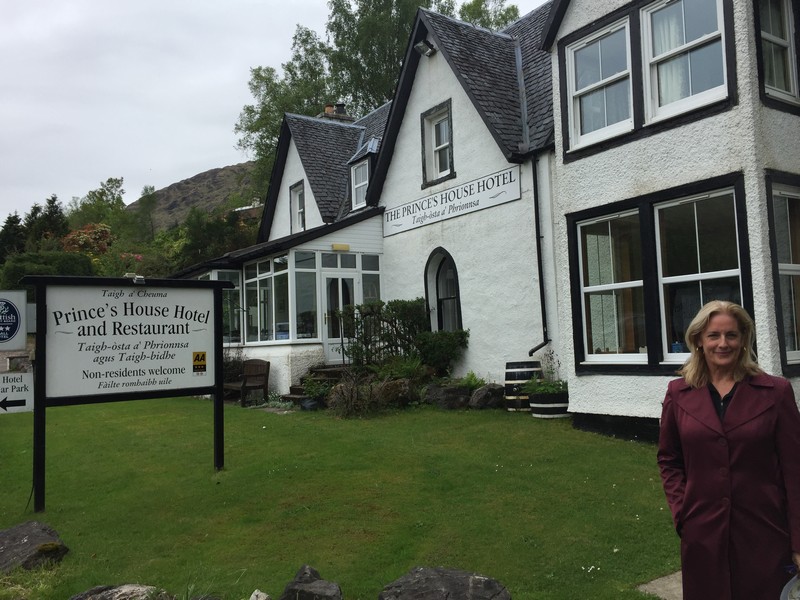 Glenfinnan:
Glenfinnan:If there is anything I question about the end result of the itinerary, it is the overnight at Glenfinnan. True, it was close to the viaduct and made for a nice hiking experience, but the need for an actual overnight at The Prince’s House Hotel is the question. We could have seen the viaduct, then driven further and spent the night in Mallaig near the ferry for much cheaper. I normally am not overly concerned about the nightly expense of a hotel, but the one night at the Prince’s House was more expensive than two nights at the Stirling Highland Hotel. Supper at The Prince’s House was decent but pricey. Breakfast was decent but not memorable. In retrospect, I would recommend overnighting Mallaig or Fort William, or perhaps even a different accommodation in Glenfinnan.
 Portree: I had a ridiculous time trying to find a place to stay on the Isle of Skye, even when trying to book months in advance. Originally I had the only reservations I could find at the small town of Broadford. Broadford was quite a bit further from the sights on west Skye that I wanted to see. Luckily the kind folks at The Pink Guest House gave me the email address for the Marine House located on the Portree harbor. The Marine House had no reservation system on-line, but after exchanging several pleasant emails with the owner (Fiona) I was able to finally book for two nights. I never really knew what the place looked like until we showed up.
Portree: I had a ridiculous time trying to find a place to stay on the Isle of Skye, even when trying to book months in advance. Originally I had the only reservations I could find at the small town of Broadford. Broadford was quite a bit further from the sights on west Skye that I wanted to see. Luckily the kind folks at The Pink Guest House gave me the email address for the Marine House located on the Portree harbor. The Marine House had no reservation system on-line, but after exchanging several pleasant emails with the owner (Fiona) I was able to finally book for two nights. I never really knew what the place looked like until we showed up.Finding the steeply inclined road down to the harbor took more than one drive-by. After getting no answer at the address for the Marine House, we knocked on the door at the neighboring house, luckily meeting Fiona. The room was small, but had a nice window overlooking the harbor and nearby mountain (Ben Tianavaig) and the breakfasts were lovely. The bathroom was not en-suite, shared with one other guest room, so getting up in the middle of the night was a little more adventurous. Parking was free and literally at water’s edge. The Marine House was centrally located in Portree and had several restaurants nearby, though many of those had hopeless lines of people waiting to get in. Speaking of those crowded restaurants, I’d like to give a special mention to No 1 Bosville Terrace. It’s a small but excellent restaurant on a hill overlooking the harbor, and an easy walk from those too busy areas – we ate there both nights. Regarding the Marine House, we enjoyed our morning chats with Fiona and her insight into all things Skye. I thoroughly recommend considering it when looking for accommodations on Skye.
 Inverness:
Inverness:After the B&B experience in Portree, the Craigmonie Hotel was a refreshingly traditional hotel with a front desk and decent rooms with en-suite bathrooms. Unfortunately the rooms are not air-conditioned, but that is the standard in Scotland. We were within easy walking distance of the Inverness town center. Parking was free and available. The included breakfast was cafeteria style to accommodate the number of guests, and was very acceptable. The exterior was from the 1880’s and quite attractive, complete with a small wicker sculpture of Nessie. We only had one night, but I would stay here again.
 Pitlochry:
Pitlochry:Missing our first night in Edinburgh made Pitlochry our longest stay of the trip at three nights. Happily for us I made an excellent choice by booking The Claymore. The second floor room had nice bay type windows overlooking the front lawn. Furnishings were tasteful and classy. Parking was plentiful and free. Breakfasts were amazing. Diane and Graeme were excellent, friendly hosts. The town center was an easy stroll along the main road. We tried sleeping with the windows open for the cool breeze, but that leads to my only complaint. There was a small patio area beneath those windows, which during our stay were occupied by wine drinking, card playing German tourists who loudly enjoyed themselves until midnight each night.
 Edinburgh International Airport:
Edinburgh International Airport:As was the custom, our last night in Scotland meant it was time to be near the airport. The Doubletree at EDI is showing its age, but still is decent and an easy walk to the airport. We arrived with a few hours left in the day despite driving in from Pitlochry and spending time in St. Andrews. The excellent bus system at airport allowed for us to use that last little bit of time to finish off with an evening in Edinburgh. If I’m ever back in Edinburgh, I’ll look at other, more modern options for a last night near the airport. The Doubletree was good enough, and I would consider staying here again.
 The Royal Mile: Castlehill, High Street and Canongate make up this stretch of Old Edinburgh, running from Edinburgh Castle in the north down to the Holyrood Palace. During our two days we journeyed the entire length, and it worth the effort. Interesting Closes and architectural gems abound and are a big part of what makes Edinburgh so enjoyable for a visitor. Uniformed pipers and street performers compete for attention in a pedestrian friendly environment.
The Royal Mile: Castlehill, High Street and Canongate make up this stretch of Old Edinburgh, running from Edinburgh Castle in the north down to the Holyrood Palace. During our two days we journeyed the entire length, and it worth the effort. Interesting Closes and architectural gems abound and are a big part of what makes Edinburgh so enjoyable for a visitor. Uniformed pipers and street performers compete for attention in a pedestrian friendly environment.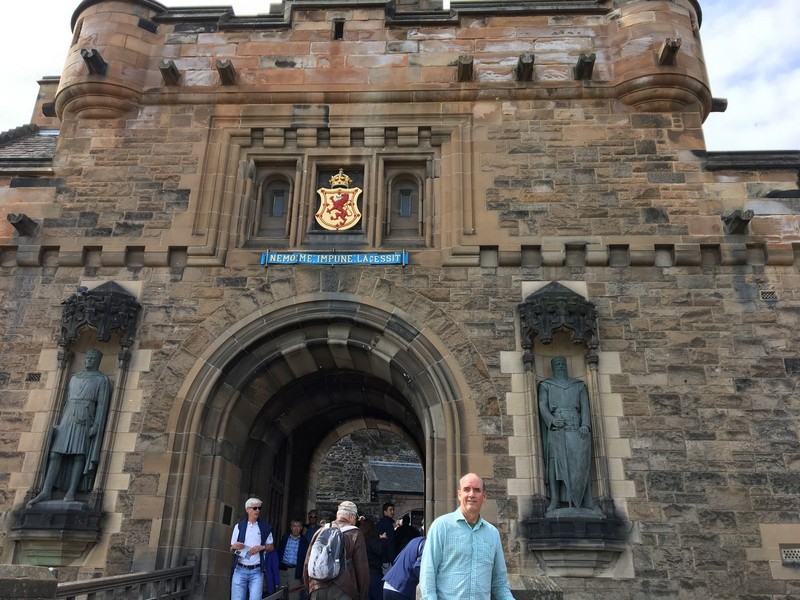 Edinburgh Castle:You know you’re somewhere special as you enter the esplanade leading up to the castle, home of the internationally famous Military Tattoo held each August. The castle greets you with statues of William Wallace and Robert the Bruce at the gatehouse. The fortress dominates the Edinburgh skyline, and the views of the city are worth the sometimes steep inclines. Be sure to get on one of the free guided tours that organize after you pass the gatehouse to get a nice overview of the large complex.
Edinburgh Castle:You know you’re somewhere special as you enter the esplanade leading up to the castle, home of the internationally famous Military Tattoo held each August. The castle greets you with statues of William Wallace and Robert the Bruce at the gatehouse. The fortress dominates the Edinburgh skyline, and the views of the city are worth the sometimes steep inclines. Be sure to get on one of the free guided tours that organize after you pass the gatehouse to get a nice overview of the large complex.Residing within the castle grounds and well worth investing time in are the: National War Museum (I enjoyed as a history buff), Royal Palace (nicely maintained with period furnishings and artwork), tiny St Margaret’s Chapel (dating back to the 12th century), Scottish National War Memorial (a reminder of how much this small country has sacrificed), museums for the Royal Scots Dragoon Guards and the Royal Regiment for Scotland (much history, uniforms, weapons, artifacts to include a French Imperial Eagle captured during the Napoleonic wars).
The Crown Room deserves a special mention. Here you can find the Stone of Scone, the traditional coronation seat of Scottish kings dating back hundreds of years. More beautiful are the Honors of Scotland: the crown, the scepter and the sword. These are the oldest in Britain, and all of these items have had a turbulent and interesting past, the crown being worn by Mary, Queen of Scots at her coronation.
Very noticeable throughout the castle visit is the constant display of the Royal Coat of Arms of Scotland. The most noticeable part of the coat of arms to the casual observer is that, depending on the version, it has either one or two crowned and chained white unicorns on the side(s). Some research reveals that the unicorn represents Christ, while a crowned and chained unicorn represents a risen Christ. This coat of arms can be seen throughout Scotland, especially in the castles.
 St Giles’ Cathedral: St Giles is an iconic, beautiful cathedral centered on the Royal Mile. Like many churches that suffered through the reformation wars, much of the interior beauty is lacking compared to the magnificent examples in Catholic countries such as Italy or Austria. There is still much to appreciate, including the Thistle Chapel and the stained glass. Where else can you find angels with bagpipes carved in the stone? I should mention here that you must pay a small fee to take pictures, but it’s well worth it.
St Giles’ Cathedral: St Giles is an iconic, beautiful cathedral centered on the Royal Mile. Like many churches that suffered through the reformation wars, much of the interior beauty is lacking compared to the magnificent examples in Catholic countries such as Italy or Austria. There is still much to appreciate, including the Thistle Chapel and the stained glass. Where else can you find angels with bagpipes carved in the stone? I should mention here that you must pay a small fee to take pictures, but it’s well worth it. Holyrood Palace:We walked the south end of the Royal Mile to get to Holyrood Palace, only to find that tickets were not being sold due to the presence of a resident Royal. Gates were locked and armed guards were in clear view. We observed it as much as we could from the outside, but our disappointment was short-lived as we still had plenty to see.
Holyrood Palace:We walked the south end of the Royal Mile to get to Holyrood Palace, only to find that tickets were not being sold due to the presence of a resident Royal. Gates were locked and armed guards were in clear view. We observed it as much as we could from the outside, but our disappointment was short-lived as we still had plenty to see.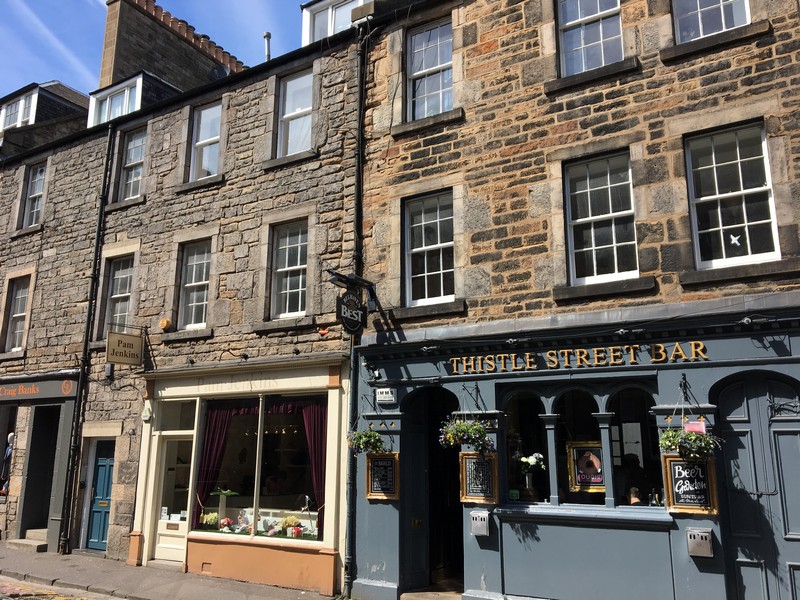 New Town:The Georgian era “New Town” is a light walk from the Royal Mile, where sights such as the towering, gothic Walter Scott monument can be taken in along the way. The restored Georgian House on Charlotte Square is worth the time to visit, providing a glimpse of life as a wealthy family living in the city in the early 1800’s. There are many preserved Georgian-era facades on the townhouses in the New Town and it makes for a lovely walk.
New Town:The Georgian era “New Town” is a light walk from the Royal Mile, where sights such as the towering, gothic Walter Scott monument can be taken in along the way. The restored Georgian House on Charlotte Square is worth the time to visit, providing a glimpse of life as a wealthy family living in the city in the early 1800’s. There are many preserved Georgian-era facades on the townhouses in the New Town and it makes for a lovely walk.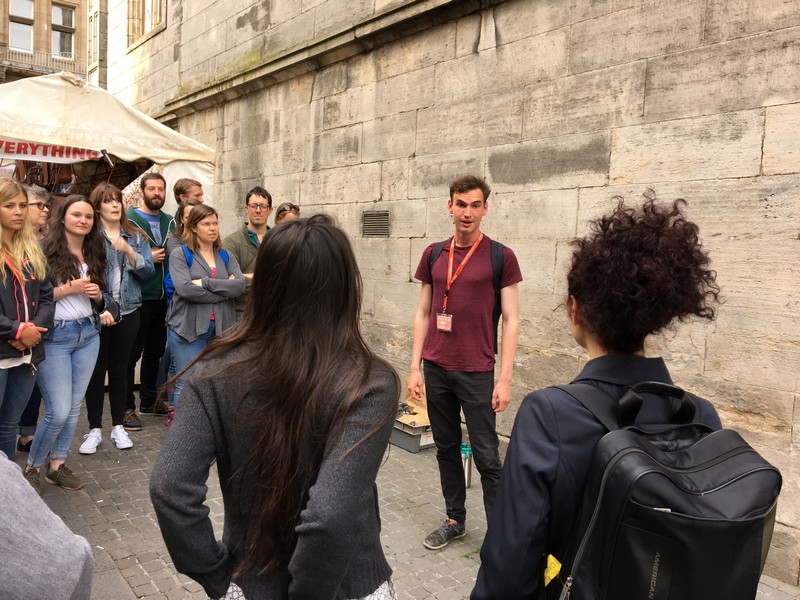 Walking Tours:The Darkside Walking Tour, our choice of one of the many tour offerings near St Giles, had a delightfully exuberant young host who guided us through the various closes and cemeteries in a fairly exhausting trek in the dusky evening in Edinburgh. We were regaled with stories of murder and mayhem and thoroughly enjoyed it. Diane managed to keep up despite her injury, and our host somehow kept the 20 of us together. We saw much of Edinburgh that we would not have seen otherwise, and we have the entertaining stories to pair with what we saw.
Walking Tours:The Darkside Walking Tour, our choice of one of the many tour offerings near St Giles, had a delightfully exuberant young host who guided us through the various closes and cemeteries in a fairly exhausting trek in the dusky evening in Edinburgh. We were regaled with stories of murder and mayhem and thoroughly enjoyed it. Diane managed to keep up despite her injury, and our host somehow kept the 20 of us together. We saw much of Edinburgh that we would not have seen otherwise, and we have the entertaining stories to pair with what we saw.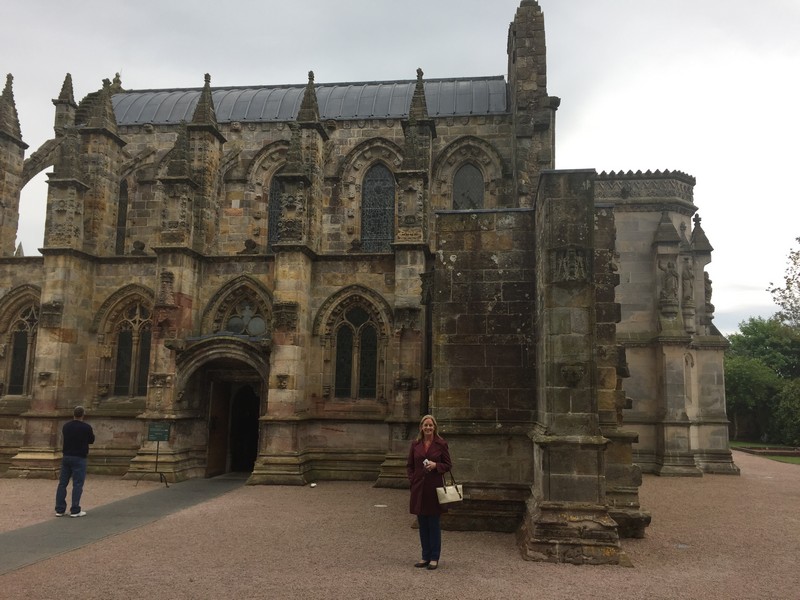 Rosslyn Chapel:If you have ever seen my distant cousin, Tom Hanks, in his role as Professor Robert Langdon in the movie “The Da Vinci Code”, then you have seen some glimpses of mysterious Rosslyn Chapel. Originally I had planned to do this as a day trip from Edinburgh, but instead stopped by as a short detour on my way to Stirling. I could not be happier with the decision to make that extra effort to see the chapel. The nicely executed welcome center organizes the visitors into manageable groups for touring the small space. The exterior is much more ornate in person than any of the pictures convey, and the interior even much more so. A guide talks the seated group through the various sculptures of note, and time is provided afterwards for closer individual inspection and questions. The incredible detail and overwhelming impact of so much artistry is such a small space is something no picture or movie can translate.
Rosslyn Chapel:If you have ever seen my distant cousin, Tom Hanks, in his role as Professor Robert Langdon in the movie “The Da Vinci Code”, then you have seen some glimpses of mysterious Rosslyn Chapel. Originally I had planned to do this as a day trip from Edinburgh, but instead stopped by as a short detour on my way to Stirling. I could not be happier with the decision to make that extra effort to see the chapel. The nicely executed welcome center organizes the visitors into manageable groups for touring the small space. The exterior is much more ornate in person than any of the pictures convey, and the interior even much more so. A guide talks the seated group through the various sculptures of note, and time is provided afterwards for closer individual inspection and questions. The incredible detail and overwhelming impact of so much artistry is such a small space is something no picture or movie can translate.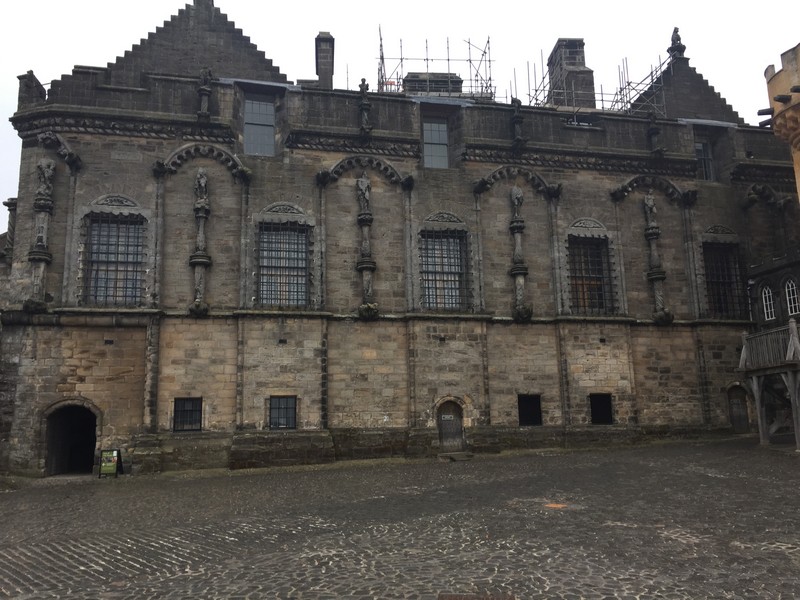 Stirling Castle: We arrived at Stirling Castle late in the day, so unfortunately some of the actor’s portrayals had ceased and attractions were in their last stages. We still managed to get a spot in the last guided tour group of the day. It was a nice overview of the castle, but I think our guide was a little tired. Unique to the castle is the “Stirling Heads” display, a set of large wooden medallions carved in the 16th century of the head profiles of a variety of political and biblical figures. Also of note are the large Stirling Tapestries, the kitchens and the beautifully decorated Royal Palace. The Church of the Holy Rood next door is worth a look as well, being the place where James VI was crowned. The countryside views from the hilltop perch of the castle are excellent.
Stirling Castle: We arrived at Stirling Castle late in the day, so unfortunately some of the actor’s portrayals had ceased and attractions were in their last stages. We still managed to get a spot in the last guided tour group of the day. It was a nice overview of the castle, but I think our guide was a little tired. Unique to the castle is the “Stirling Heads” display, a set of large wooden medallions carved in the 16th century of the head profiles of a variety of political and biblical figures. Also of note are the large Stirling Tapestries, the kitchens and the beautifully decorated Royal Palace. The Church of the Holy Rood next door is worth a look as well, being the place where James VI was crowned. The countryside views from the hilltop perch of the castle are excellent.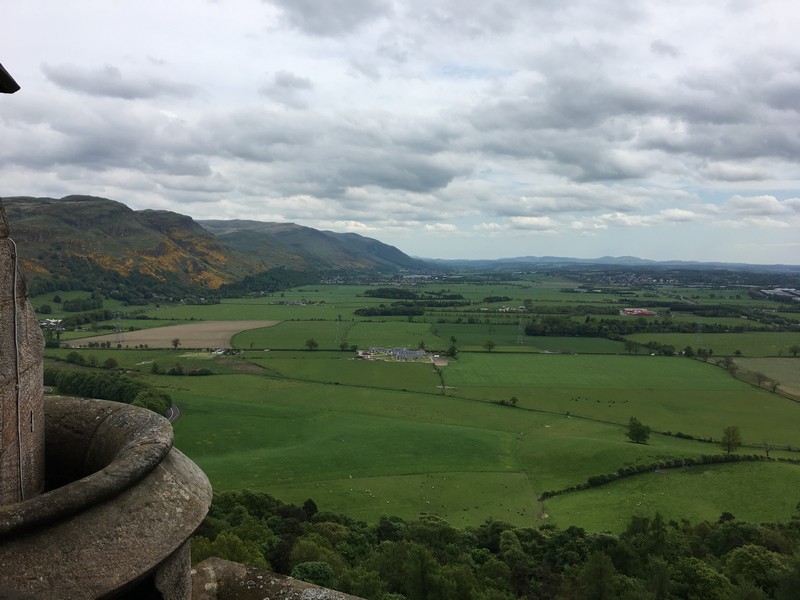 The National Wallace Monument: I originally had the bright idea that we would walk from our hotel in Stirling to the Wallace Monument. We made it as far as the site of the Battle of Stirling Bridge before I realized it was a ridiculous idea. So we viewed the markers at Stirling Bridge before heading back to get the car. The monument is a short ride from Stirling, being prominent on the hillside and visible from anywhere nearby. The location is said to be where Wallace watched the armies of Edward I of England marshal his armies prior to the Battle of Stirling Bridge.
The National Wallace Monument: I originally had the bright idea that we would walk from our hotel in Stirling to the Wallace Monument. We made it as far as the site of the Battle of Stirling Bridge before I realized it was a ridiculous idea. So we viewed the markers at Stirling Bridge before heading back to get the car. The monument is a short ride from Stirling, being prominent on the hillside and visible from anywhere nearby. The location is said to be where Wallace watched the armies of Edward I of England marshal his armies prior to the Battle of Stirling Bridge.246 steps must be climbed to get to the viewing gallery at the top. This journey is broken up by small rooms with artifacts and activities. On display, and in remarkable condition, is the two-handed, 5ft 4in Wallace Sword, supposedly used by Wallace himself. We had a reasonably clear day for our visit, and the views from the top of the Monument are breathtaking (not that I had much breath to take after climbing 246 steps).
 Doune Castle: We had an interesting driving experience getting here, enough that I purchased a Collins Touring Map at the small gift shop. Doune Castle is mostly a ruin, but there are some restored parts such as the Lord’s Tower. For me the more interesting aspects of the castle is its association with Monty Python (The Holy Grail), two TV series (Outlander, Game of Thrones) and the movie The Outlaw King. Audio guides have Terry Jones of Monty Python and Sam Heughan from Outlander giving insights and stories from their two very different perspectives. Given the state of the castle compared to Edinburgh and Stirling, the entertainment aspect made it a very enjoyable visit.
Doune Castle: We had an interesting driving experience getting here, enough that I purchased a Collins Touring Map at the small gift shop. Doune Castle is mostly a ruin, but there are some restored parts such as the Lord’s Tower. For me the more interesting aspects of the castle is its association with Monty Python (The Holy Grail), two TV series (Outlander, Game of Thrones) and the movie The Outlaw King. Audio guides have Terry Jones of Monty Python and Sam Heughan from Outlander giving insights and stories from their two very different perspectives. Given the state of the castle compared to Edinburgh and Stirling, the entertainment aspect made it a very enjoyable visit. The Kelpies: Built as recently as 2013, these 30 meter (approximately 100 feet) high sculptures are worth a close look, and are an easy drive from either Doune Castle or Stirling to the town of Falkirk. Based on the mythical water creatures, the resulting artwork pays homage to the role of the horse in local industry and agriculture. There is a park with a specially constructed water lock and basin around the base. We enjoyed strolling the grounds and admiring the impressive metal work. An ice cream from the nearby food stand didn’t hurt either.
The Kelpies: Built as recently as 2013, these 30 meter (approximately 100 feet) high sculptures are worth a close look, and are an easy drive from either Doune Castle or Stirling to the town of Falkirk. Based on the mythical water creatures, the resulting artwork pays homage to the role of the horse in local industry and agriculture. There is a park with a specially constructed water lock and basin around the base. We enjoyed strolling the grounds and admiring the impressive metal work. An ice cream from the nearby food stand didn’t hurt either.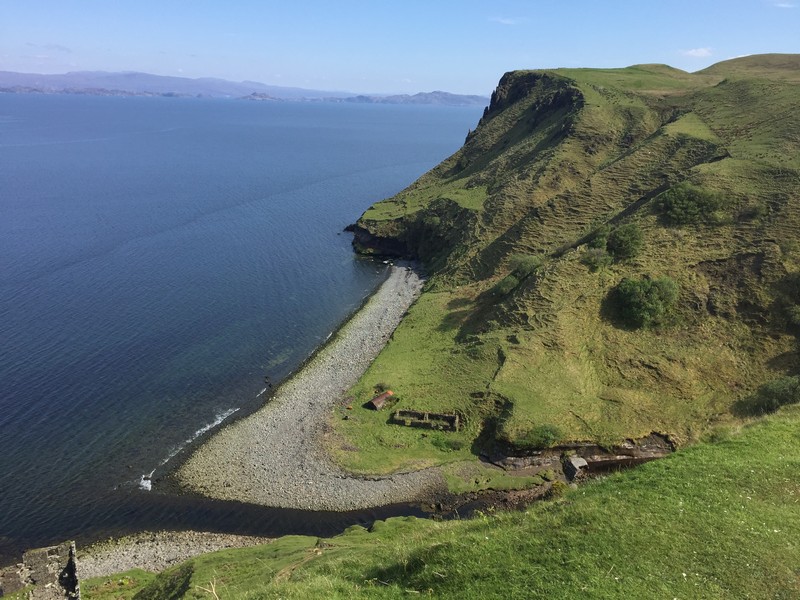 Northern Loop Drive: I already discussed driving the sometimes ridiculously small roads in Scotland, but it is worth a second mention that parking can be difficult, especially in the summer. Often cars were lining both sides of the road for hundreds of feet. This was in May, so I can’t imagine how bad it could be during July and August. Our trusty Vauxhall Mokka mini-SUV was small enough to fit some tight parking, and I can’t emphasize enough the value of having a smaller vehicle in these conditions.
Northern Loop Drive: I already discussed driving the sometimes ridiculously small roads in Scotland, but it is worth a second mention that parking can be difficult, especially in the summer. Often cars were lining both sides of the road for hundreds of feet. This was in May, so I can’t imagine how bad it could be during July and August. Our trusty Vauxhall Mokka mini-SUV was small enough to fit some tight parking, and I can’t emphasize enough the value of having a smaller vehicle in these conditions.Despite the crowds, the northern loop is a great drive. We stopped and hike for a bit at Storr, followed by some more at the Kilt Rock viewpoint and the Quiraing. Skye’s mountains and features are on full display for this drive. We stopped at the Skye Museum of Island Life, but it was late enough in the day that it had closed. The grave of Flora MacDonald, famous for helping to rescue Prince Charlie, is in a nearby cemetery here as well. Time had caught up to us, so we were unable to get to The Fairy Glen.
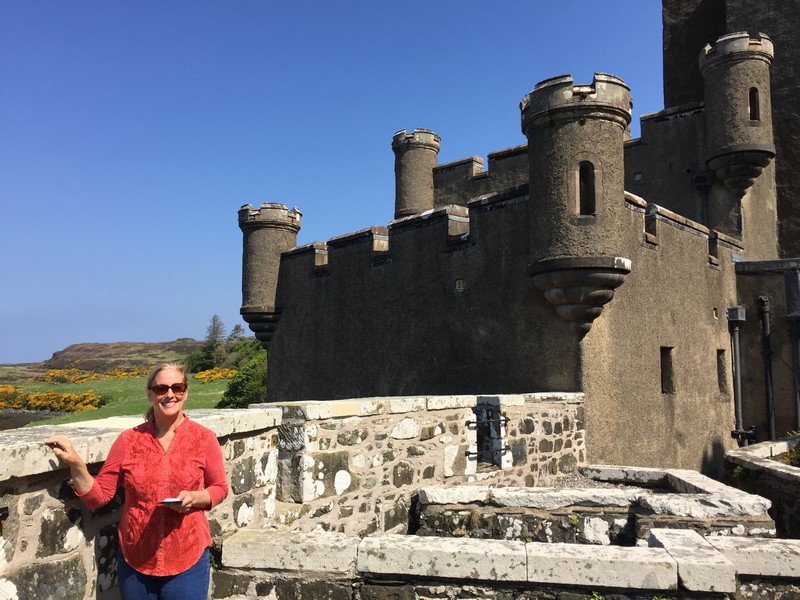 Dunvegan Castle: One of the joys of touring western Skye is smaller crowds and a slower pace. We stopped at a small but interesting cemetery outside of the town of Dunvegan. There were many old Celtic crosses, and many tombstones with bearing the names of MacLeod and MacDonald. Continuing into Dunvegan, the castle does not have that hilltop dominance that Stirling and Edinburgh castles have. This fortress is more of a coastal strongpoint, looming large over the waters of Loch Dunvegan. The structure is in great shape, both inside and out, and reflects the fact that it is still a residence.
Dunvegan Castle: One of the joys of touring western Skye is smaller crowds and a slower pace. We stopped at a small but interesting cemetery outside of the town of Dunvegan. There were many old Celtic crosses, and many tombstones with bearing the names of MacLeod and MacDonald. Continuing into Dunvegan, the castle does not have that hilltop dominance that Stirling and Edinburgh castles have. This fortress is more of a coastal strongpoint, looming large over the waters of Loch Dunvegan. The structure is in great shape, both inside and out, and reflects the fact that it is still a residence.I enjoyed seeing the paintings of past clan chiefs, recognizing a few from my readings, such as Norman MacLeod, aka “The Wicked Man”, who supported the government forces during and after the Battle of Culloden. He was known for burning over 300 homes of the MacLeod’s on the neighboring island of Raasay who had supported the uprising, as well as wasting the lands of the Grants of Glenmoriston. Also present were many artifacts from supporters of the Jacobite cause, including Prince Charlie’s waistcoat and items from Flora MacDonald. As a history buff, I thoroughly enjoyed the portraits, tartans, weapons and relics. Of course the famous (at least to MacLeods) Fairy Flag is on display. The current clan chief, Hugh Magnus MacLeod of MacLeod, is featured in a video discussing the MacLeod clan and the castle grounds. A small gift shop at the exit managed to impress me enough that I walked away with a clan badge (“Hold Fast!”) and a clan tartan scarf.
The gardens were an unexpected pleasure, with three separate spaces: The Walled Garden, The Round Garden, and The Water Garden. The many flowers and plants were wonderful, although Diane enjoyed them more with her green thumb. The Water Garden, having a large waterfall, bridge and small streams, was especially enjoyable.
This castle and the surrounding area were, for me at least, one of the driving reasons for visiting Scotland. I would have liked some time to drive to what is left of the small crofting town of Galtrigill, where “my” MacLeods were supposedly from, but the road was almost non-existent, and time was ticking on our one full day on Skye.
 Talisker Distillery: Stopping by Skye’s own distillery seemed like something we should do, so we took the short detour to the small town of Carbost. Tours are offered on the hour, and we had just missed ours, so the small pub called “The Old Inn” provided some good food and provided the only time I heard a family at a nearby table speaking what I am fairly certain was Gaelic. The tour itself was informative but quite industrial. If you like whisky, then it is certainly worth a stop. This distillery provided an good reference point when we were to later tour the much smaller Edradour Distillery in Pitlochry.
Talisker Distillery: Stopping by Skye’s own distillery seemed like something we should do, so we took the short detour to the small town of Carbost. Tours are offered on the hour, and we had just missed ours, so the small pub called “The Old Inn” provided some good food and provided the only time I heard a family at a nearby table speaking what I am fairly certain was Gaelic. The tour itself was informative but quite industrial. If you like whisky, then it is certainly worth a stop. This distillery provided an good reference point when we were to later tour the much smaller Edradour Distillery in Pitlochry. The Fairy Pools: With an eastern skyline dominated by the mountains of the Black Cullins, this was my favorite hike of the entire visit. We had a nice, clear day and some fine temperatures. The trail follows a small stream with a series of small falls that have created pools of crystal clear water. Be ready for a hike and enjoy the scenery. Note though that parking again can be a challenge on a beautiful day. A good part of our hike was getting to the trail from our parking spot along the side of the road.
The Fairy Pools: With an eastern skyline dominated by the mountains of the Black Cullins, this was my favorite hike of the entire visit. We had a nice, clear day and some fine temperatures. The trail follows a small stream with a series of small falls that have created pools of crystal clear water. Be ready for a hike and enjoy the scenery. Note though that parking again can be a challenge on a beautiful day. A good part of our hike was getting to the trail from our parking spot along the side of the road.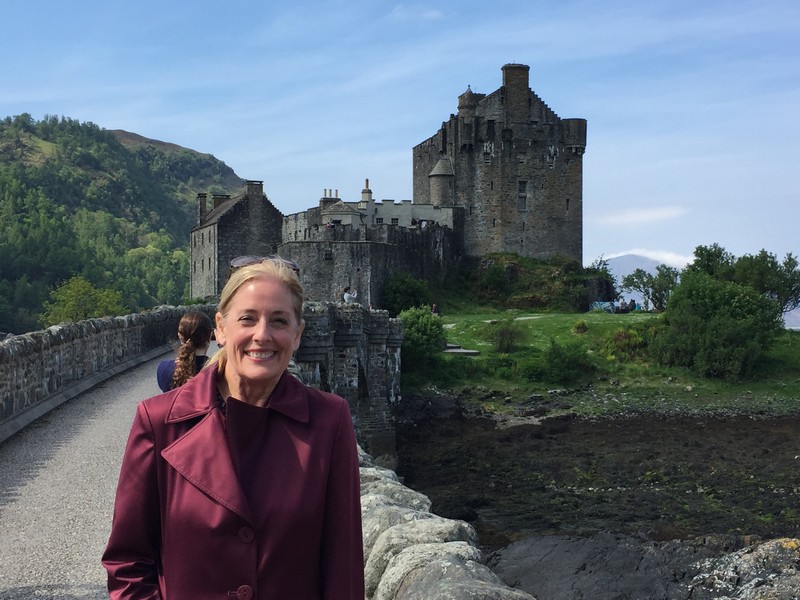 Eilean Donan Castle: Probably one of the most iconic castles in Scotland, Eilean Donan well worth a visit. Although primarily a 20th century romantic reconstruction of what the castle might have looked like, it is nevertheless a beautiful and impressive structure. The interior has been called “a rubbly Edwardian stage-set for life in the Middle Ages”, but there are still some nice artifacts from the MacRae family to be found inside (the primary force behind the reconstruction was Lt. Col. John MacRae-Gilstrap). Braving the crowds from the tour buses is worth the effort.
Eilean Donan Castle: Probably one of the most iconic castles in Scotland, Eilean Donan well worth a visit. Although primarily a 20th century romantic reconstruction of what the castle might have looked like, it is nevertheless a beautiful and impressive structure. The interior has been called “a rubbly Edwardian stage-set for life in the Middle Ages”, but there are still some nice artifacts from the MacRae family to be found inside (the primary force behind the reconstruction was Lt. Col. John MacRae-Gilstrap). Braving the crowds from the tour buses is worth the effort. Uruquart Castle: Contrasted to Eilean Donan, Uruquart Castle barely exists. What they do have is an excellent welcome center with an interesting depiction of the construction and history of the castle. We had an entertaining tour guide who walked us through what little remains. The views of Loch Ness are quite nice, and there is a tour-bus-ready cafeteria at the welcome center with reasonably digestible offerings.
Uruquart Castle: Contrasted to Eilean Donan, Uruquart Castle barely exists. What they do have is an excellent welcome center with an interesting depiction of the construction and history of the castle. We had an entertaining tour guide who walked us through what little remains. The views of Loch Ness are quite nice, and there is a tour-bus-ready cafeteria at the welcome center with reasonably digestible offerings.Nessie-oriented attractions are in the immediate area around the castle ruins, but my inherent skepticism outweighed any potential enjoyment from visiting.
 Culloden Battlefield: Drummossie Moor is not that impressive from the road, especially on dreary cold and wet morning. The Culloden Visitor Center is, however, as good as any battlefield exhibition that I’ve seen. Swords, guns, cannons, documents and a large moving map display give full testament to the battle. Joining with a tour guide allows you to retrace the actual earth where the tragedy happened.
Culloden Battlefield: Drummossie Moor is not that impressive from the road, especially on dreary cold and wet morning. The Culloden Visitor Center is, however, as good as any battlefield exhibition that I’ve seen. Swords, guns, cannons, documents and a large moving map display give full testament to the battle. Joining with a tour guide allows you to retrace the actual earth where the tragedy happened.I’ve been to several battlefields, but none have provoked a sense of loss as much as this one. Knowing that hundreds of men are buried on the grounds only adds weigh to that feeling. A lasting image from the many displays at the center are a set of Scottish swords, each with their tip and tang broken off to render them useless. The powerless final state of those weapons seemed to symbolize the end of the independent highland way of life.
 Clava Cairns: Although the Clava Cairns are near Culloden, finding them is not as straightforward as you might think. A very small (one lane) bridge takes you across the River Nairn, where suddenly you see some tall, worn stones standing vigil beside the road. A public park has been made of the site, complete with picnic tables. The cairns are very accessible, with the ability to touch and walk to the interior of the mounds. There is some speculation as to how they may have looked in the Bronze Age, but what remains is fascinating. Some stonework can still be seen despite hundreds of years of Scottish winters.
Clava Cairns: Although the Clava Cairns are near Culloden, finding them is not as straightforward as you might think. A very small (one lane) bridge takes you across the River Nairn, where suddenly you see some tall, worn stones standing vigil beside the road. A public park has been made of the site, complete with picnic tables. The cairns are very accessible, with the ability to touch and walk to the interior of the mounds. There is some speculation as to how they may have looked in the Bronze Age, but what remains is fascinating. Some stonework can still be seen despite hundreds of years of Scottish winters.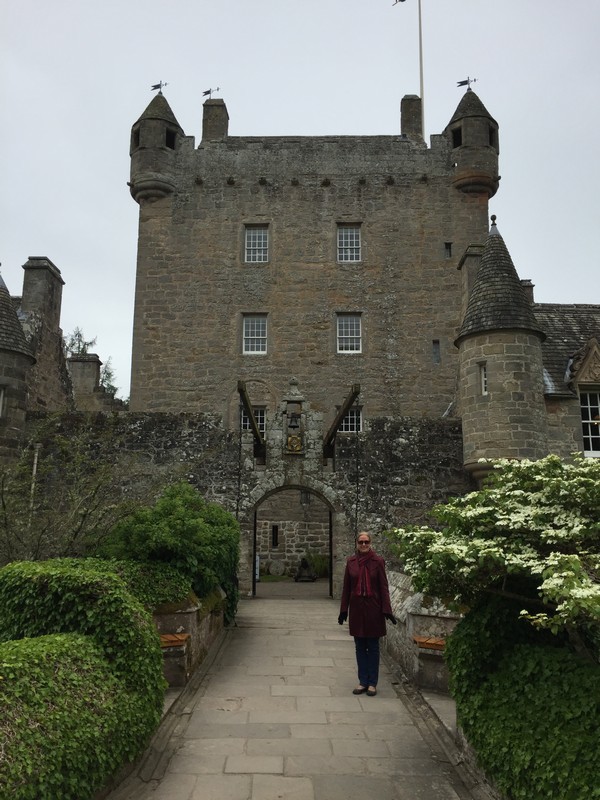 Cawdor Castle: A phenomenon that I have experienced on previous adventures began to make itself known with a slight variation: museum burnout, only now the museums were castles. At this point in the journey, we had visited six castles in various states of preservation (not counting Inverness, only viewed from the outside). They were all wonderful and unique, but at the same time, like the museums in Paris or Vienna, with repetition they begin to take on a certain sameness. So it was with some trepidation that we decided to stick to our itinerary make the short drive to Cawdor.
Cawdor Castle: A phenomenon that I have experienced on previous adventures began to make itself known with a slight variation: museum burnout, only now the museums were castles. At this point in the journey, we had visited six castles in various states of preservation (not counting Inverness, only viewed from the outside). They were all wonderful and unique, but at the same time, like the museums in Paris or Vienna, with repetition they begin to take on a certain sameness. So it was with some trepidation that we decided to stick to our itinerary make the short drive to Cawdor.Luckily Cawdor Castle is a genuine jewel, being the current residence a member of the Campbell family, the Dowager Countess Cawdor. Not towering on a hilltop, the exterior is still impressively tall and well maintained. The interior loaded with antiques, weaponry and family heirlooms. The remains of a hawthorn tree rest in the dungeon, dating back over 500 years to the founding of the castle. Everything is presented with meticulous care. The Countess herself narrates the audio guide that useful for individual touring. The lovely gardens are complex with surprising sculptures. We were very pleased that we made the effort to visit.
 Blair Atholl Highland Games: We spent a day at nearby Blair Atholl for the Highland Games on the Blair Castle grounds. I have attended Highland Games in the USA, so it was interesting to note the similarities and the differences. It was fun watching the Queen’s Own Atholl Guards parade onto the ground to start the games. Competing sounds filled the air as Solo pipers played for their respective judges while brightly dressed Highland dancers vied for score to a separate tune. Most importantly, the ice cream was especially delicious on that clear summer day.
Blair Atholl Highland Games: We spent a day at nearby Blair Atholl for the Highland Games on the Blair Castle grounds. I have attended Highland Games in the USA, so it was interesting to note the similarities and the differences. It was fun watching the Queen’s Own Atholl Guards parade onto the ground to start the games. Competing sounds filled the air as Solo pipers played for their respective judges while brightly dressed Highland dancers vied for score to a separate tune. Most importantly, the ice cream was especially delicious on that clear summer day.The castle was open but was super crowded, so we passed on going inside.
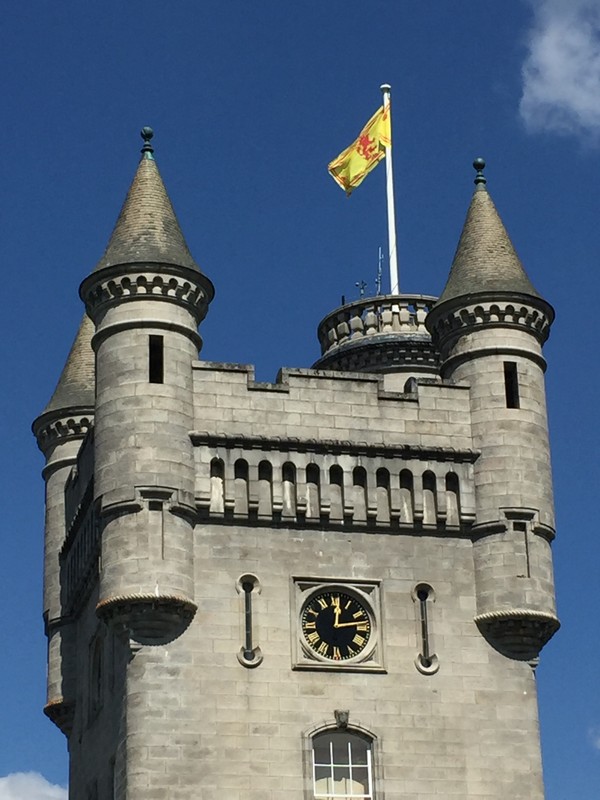 Balmoral: Balmoral is a short and exciting drive from Pitlochry. Only small roads (A924, B950) connect Pitlochry to the still-very-small-but-bigger A93 that runs to Balmoral. The B950 is where we had our livestock in the road experience. We sat for probably 10 minutes while the handlers moved the animals from the pavement. It was a very unique experience, waiting for the unconcerned animals to clear the path. Balmoral itself has an interesting carriage house and magnificent gardens. The only room open to the public is the ballroom, worth seeing for the many Windsor family artifacts.
Balmoral: Balmoral is a short and exciting drive from Pitlochry. Only small roads (A924, B950) connect Pitlochry to the still-very-small-but-bigger A93 that runs to Balmoral. The B950 is where we had our livestock in the road experience. We sat for probably 10 minutes while the handlers moved the animals from the pavement. It was a very unique experience, waiting for the unconcerned animals to clear the path. Balmoral itself has an interesting carriage house and magnificent gardens. The only room open to the public is the ballroom, worth seeing for the many Windsor family artifacts.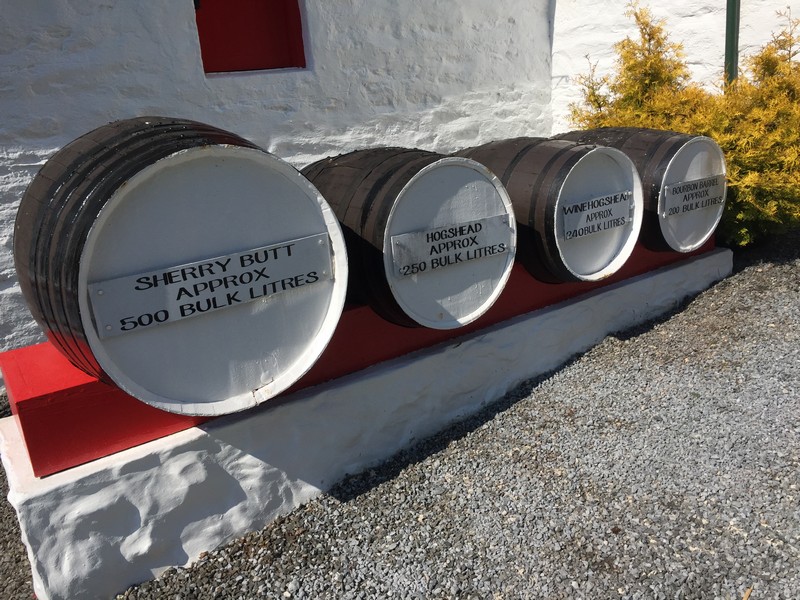 Edradour Distillery: Edradour Distillery is Pitlochry’s little gem, having held the claim to being Scotland’s smallest distillery until recently. We thoroughly enjoyed the grounds with the tiny creek, the Edradour Burn, adding some extra character. As we waited for our tour, we enjoyed a coffee at the bar, and were surprised when we were given the Edradour-emblazed mugs to keep. We were given two different whiskys to try that pointed out the difference between “peated” (read smoky) and non-peated flavors. Again we were given our nice little sampling glasses as souvenirs.
Edradour Distillery: Edradour Distillery is Pitlochry’s little gem, having held the claim to being Scotland’s smallest distillery until recently. We thoroughly enjoyed the grounds with the tiny creek, the Edradour Burn, adding some extra character. As we waited for our tour, we enjoyed a coffee at the bar, and were surprised when we were given the Edradour-emblazed mugs to keep. We were given two different whiskys to try that pointed out the difference between “peated” (read smoky) and non-peated flavors. Again we were given our nice little sampling glasses as souvenirs.